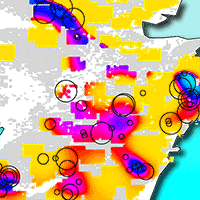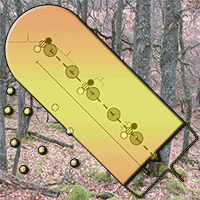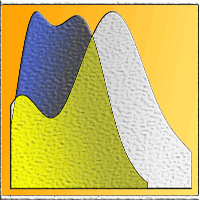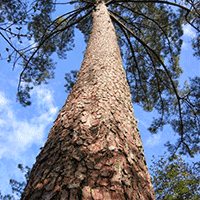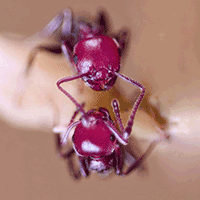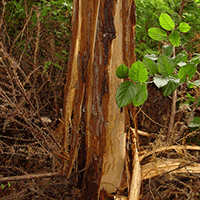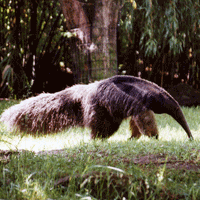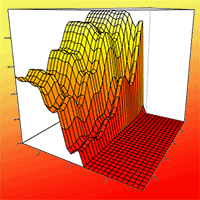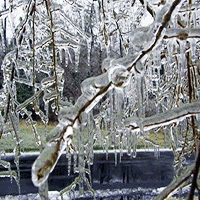The economic loss caused by herbivore browsing in forest plantations is a concerning problem in many areas around the world. Information on the spatial distribution of browsing damage is important for forest owners when selecting locations for new plantations, because planting trees in areas of high browsing pressure increases economic losses. Although it is difficult to survey browsing damage across large areas, sporadic sampling data on browsing damage are often collected by foresters, governments, and researchers. Thus, in this study, we applied a generalized additive model (GAM) for analysis of sporadic data to reveal large-scale spatial variation in deer (Cervus nippon) browsing damage. A map of browsing pressure produced by a GAM that used years after planting (plantation age) and location as independent factors showed a few areas of high browsing pressure. In addition, browsing damage increased with increasing plantation age, and plantation stands aged 2+ years showed more browsing damage. Areas with high browsing damage estimated based on plantation stands aged 2+ years generally coincided with areas of high deer abundance, with some exceptions. Thus, this model reflects large-scale browsing damage relatively well and will help forest owners to avoid locating new plantations in areas of high browsing pressure.
Keywords
, , , ,
Citation
Suzuki KK, Watanabe Y, Kubota T, Kuwano Y, Kawauchi Y, Yamagawa H, Yasuda M, Kondoh H, Nomiya H, Oka T (2021). Large-scale spatial distribution of deer browsing damage to young tree plantations. iForest 14: 34-40. - doi: 10.3832/ifor3387-013
Academic Editor
Giorgio Alberti
Paper history
Received: Feb 27, 2020
Accepted: Nov 12, 2020
First online: Jan 14, 2021
Publication Date: Feb 28, 2021
Publication Time: 2.10 months
© SISEF - The Italian Society of Silviculture and Forest Ecology 2021
Open Access
This article is distributed under the terms of the Creative Commons Attribution-Non Commercial 4.0 International (https://creativecommons.org/licenses/by-nc/4.0/), which permits unrestricted use, distribution, and reproduction in any medium, provided you give appropriate credit to the original author(s) and the source, provide a link to the Creative Commons license, and indicate if changes were made.

Breakdown by View Type
(Waiting for server response...)
Article Usage
Total Article Views: 38444
(from publication date up to now)
Breakdown by View Type
HTML Page Views: 32110
Abstract Page Views: 2602
PDF Downloads: 3036
Citation/Reference Downloads: 3
XML Downloads: 693
Web Metrics
Days since publication: 1804
Overall contacts: 38444
Avg. contacts per week: 149.17
Article Citations
Article citations are based on data periodically collected from the Clarivate Web of Science web site
(last update: Mar 2025)
Total number of cites (since 2021): 10
Average cites per year: 2.00
Publication Metrics
by Dimensions ©
Articles citing this article
List of the papers citing this article based on CrossRef Cited-by.
(1)
Balazy R, Ciesielski M, Sterenczak K, Borowski Z (2016)The role of topography in the distribution and intensity of damage caused by deer in Polish mountain forests. PLoS One 11: e0165 967.
CrossRef |
Gscholar
(2)
Bergquist J, Orlander G (1998)Browsing damage by roe deer on Norway spruce seedlings planted on clearcuts of different ages: 1. Effect of slash removal, vegetation development, and roe deer density. Forest Ecology and Management 105: 283-293.
CrossRef |
Gscholar
(3)
Bergström R, Bergqvist G (1997)Frequencies and patterns of browsing by large herbivores on conifer seedlings. Scandinavian Journal of Forest Research 12: 288-294.
CrossRef |
Gscholar
(4)
Borkowski J, Dobrowolska D, Dabrowski W, Banul R, Zaluski D (2017)Young conifer stands form a deer browsing refuge for an oak admixture: silvicultural implications for forest regeneration under herbivore pressure. European Journal of Forest Research 136: 787-800.
CrossRef |
Gscholar
(5)
Brousseau M, Thiffault N, Beguin J, Roy V, Tremblay J-P (2017)Deer browsing outweighs the effects of site preparation and mechanical release on balsam fir seedlings performance: implications to forest management. Forest Ecology and Management 405: 360-366.
CrossRef |
Gscholar
(6)
Bulinski J, McArthur C (2000)Spatial distribution of browsing damage and mammalian herbivores in Tasmanian eucalypt plantations. Australian Forestry 63: 27-33.
CrossRef |
Gscholar
(7)
Candy SG (2004)Modelling catch and effort data using generalised linear models, the Tweedie distribution, random vessel effects and random stratum-by-year effects. CCAMLR Science 11: 59-80.
Online |
Gscholar
(8)
Conover MR (1997)Monetary and intangible valuation of deer in the United States. Wildlife Society Bulletin 25: 298-305.
Online |
Gscholar
(9)
Côté SD, Rooney TP, Tremblay J-P, Dussault C, Waller DM (2004)Ecological impacts of deer overabundance. Annual Review of Ecology, Evolution, and Systematics 35: 113-147.
CrossRef |
Gscholar
(10)
Daubenmire RF (1940)Exclosure technique in ecology. Ecology 21: 514-515.
CrossRef |
Gscholar
(11)
Enoki T, Yabe T, Koizumi T (2016)Changes in spatial patterns of sika deer distribution and herbivory of planted seedlings: a comparison before and after deer population control by culling. Journal of Forest Research 21: 84-91.
CrossRef |
Gscholar
(12)
Forney KA, Ferguson MC, Becker EA, Fiedler PC, Redfern JV, Barlow J, Vilchis IL, Ballance LT (2012)Habitat-based spatial models of cetacean density in the eastern Pacific Ocean. Endangered Species Research 16: 113-133.
CrossRef |
Gscholar
(13)
Furuichi S, Yasuda T, Kurota H, Yoda M, Suzuki K, Takahashi M, Fukuwaka M (2020)Disentangling the effects of climate and density-dependent factors on spatiotemporal dynamics of Japanese sardine spawning. Marine Ecology Progress Series 633: 157-168.
CrossRef |
Gscholar
(14)
Gill RMA (1992)A review of damage by mammals in north temperate forests: 1. Deer. Forestry 65: 145-169.
CrossRef |
Gscholar
(15)
Grüss A, Drexler M, Ainsworth CH (2014)Using delta generalized additive models to produce distribution maps for spatially explicit ecosystem models. Fisheries Research 16: 113-133.
CrossRef |
Gscholar
(16)
Horsley SB, Stout SL, De Calesta DS (2003)White-tailed deer impact on the vegetation dynamics of a northern hardwood forest. Ecological Applications 13: 98-118.
CrossRef |
Gscholar
(17)
ICCAT (1997)Report of the bluefin tuna methodology session. International Commission for the Conservation of Atlantic Tunas - ICCAT, Collective Volume of Scientific Papers 46: 187-268.
Online |
Gscholar
(18)
Iijima H, Nagaike T (2015)The factors that determine the intensities of deer browsing and debarking on broadleaf tree around artificial grasslands. Journal of Forest Research 22: 199-203.
CrossRef |
Gscholar
(19)
Iijima H, Nagaike T (2017)Appropriate vegetation indices for measuring the impacts of deer on forest ecosystems. Ecological Indicators 48: 457-463.
CrossRef |
Gscholar
(20)
Ito T (1986)Population trend of Sika deer on Kinkazan Island. Mammalian Science 26: 29-31. [in Japanese]
Gscholar
(21)
Iwamoto T, Sakata T, Nakazono T, Utaoka H, Ikeda K, Nishishita Y, Tsuneda K, Doi T (2000)Improvement of the pellet count method for the estimation of Sika deer density. Mammalian Science 40: 1-17. [in Japanese with English abstract]
Gscholar
(22)
Kaji K, Koizumi T, Ohtaishi N (1988)Effects of resource limitation on the physical and reproductive condition of Sika deer on Nakanoshima Island, Hokkaido. Acta Theriologica 33: 187-208.
CrossRef |
Gscholar
(23)
Kaji K, Miyaki M, Saitof T, Ono S, Kaneko M (2000)Spatial distribution of an expanding sika deer population on Hokkaido Island, Japan. Wildlife Society Bulletin 28: 699-707.
Online |
Gscholar
(24)
Koda R, Fujita N (2011)Is deer herbivory directly proportional to deer population density? Comparison of deer feeding frequencies among six forests with different deer density. Forest Ecology and Management 262: 432-439.
CrossRef |
Gscholar
(25)
Kondoh H, Ikeda K, Koizumi T (2007)Spatial estimation of Sika deer population density distribution. Journal of Forest Planning 13: 1-14.
CrossRef |
Gscholar
(26)
Moore NP, Hart JD, Langton SD (1999)Factors influencing browsing by fallow deer
Dama dama in young broad-leaved plantations. Biological Conservation 87: 255-260.
CrossRef |
Gscholar
(27)
Partl E, Szinovatz V, Reimoser F, Schweiger-Adler J (2002)Forest restoration and browsing impact by roe deer. Forest Ecology and Management 159: 87-100.
CrossRef |
Gscholar
(28)
Picard RR, Cook RD (1984)Cross-validation of regression models. Journal of the American Statistical Association 79: 575-583.
CrossRef |
Gscholar
(29)
R Core Team (2018)R: a language and environment for statistical computing. R Foundation for Statistical Computing, Vienna, Austria.
Online |
Gscholar
(30)
Reimoser F (2003)Steering the impacts of ungulates on temperate forests. Journal for Nature Conservation 10: 243-252.
CrossRef |
Gscholar
(31)
Saruki S, Inoue S, Shiiba Y, Nagasawa H, Ohosaki S, Kubota K (2004)Distribution and growth situation of Suzutake (
Sasamorpha borealis) damaged by grazing of Shika deer (
Cervus nippon nippon) in Miyazaki Forest of Kyushu University: case study in 2003. Bulletin of Kyushu University Forest 85: 47-54.
Gscholar
(32)
Schmidt M, Hanewinkel M, Kändler G, Kublin E, Kohnle U (2010)An inventory-based approach for modeling single-tree storm damage experiences with the winter storm of 1999 in southwestern Germany. Canadian Journal of Forest Research 40: 1636-1652.
CrossRef |
Gscholar
(33)
Shono H (2008)Application of the Tweedie distribution to zero-catch data in CPUE analysis. Fisheries Research 93: 154-162.
CrossRef |
Gscholar
(34)
Suzuki KK, Yasuda T, Kurota H, Yoda M, Hayashi A, Muko S, Takahashi M (2018)Spatiotemporal variations in the distribution of round herring eggs in the East China and Japan Seas during 1997-2013. Journal of Sea Research 142: 1-10.
CrossRef |
Gscholar
(35)
Takarabe K, Iijima H (2019)Contrasting effect of artificial grasslands on the intensity of deer browsing and debarking in forests. Mammal Study 44: 173-181.
CrossRef |
Gscholar
(36)
Takatsuki S (2009)Effects of sika deer on vegetation in Japan: a review. Biological Conservation 142: 1922-1929.
CrossRef |
Gscholar
(37)
Takatsuki S, Gorai T (1994)Effects of Sika deer on the regeneration of a
Fagus crenata forest on Kinkazan Island, northern Japan. Ecological Research 9: 115-120.
CrossRef |
Gscholar
(38)
Tremblay J-P, Hout J, Potvin F (2007)Density-related effects of deer browsing on the regeneration dynamics of boreal forests. Journal of Applied Ecology 44: 552-562.
CrossRef |
Gscholar
(39)
Tsuyama I, Nakao K, Matsui T, Higa M, Horikawa M, Kominai Y, Tanaka N (2011)Climatic controls of a keystone understory species,
Sasamorpha borealis, and an impact assessment of climate change in Japan. Annals of Forest Science 68: 689-699.
CrossRef |
Gscholar
(40)
Uno H, Inatomi Y, Ueno M, Iijima H (2019)Effects of sika deer (
Cervus nippon) and dwarf bamboo (
Sasa senanensis) on tree seedlings in a cool-temperate mixed forest on Hokkaido Island, Japan. European Journal of Forest Research 138: 929-938.
CrossRef |
Gscholar
(41)
Verheyden H, Ballon P, Bernard V, Saint-Andrieus C (2006)Variations in bark-stripping by red deer
Cervus elaphus across Europe. Mammal Review 36: 217-234.
CrossRef |
Gscholar
(42)
Yabe T, Yayota C (2012)Management techniques for effective control of overabundant sika deer populations in Kyushu. Mammalian Science 52: 114-115. [in Japanese]
Gscholar
(43)
Yamamoto T, Watanuki Y, Hazen EL, Nishizawa B, Sasaki H, Takahashi A (2015)Statistical integration of tracking and vessel survey data to incorporate life history differences in habitat models. Ecological Applications 25: 2394-2406.
CrossRef |
Gscholar
(44)
Yano T, Ohshimo S, Kanaiwa M, Hattori T, Fukuwaka M-A, Nagasawa T, Tanaka S (2017)Spatial distribution analysis of the North Pacific spiny dogfish,
Squalus suckleyi, in the North Pacific using generalized additive models. Fisheries Oceanography 26: 668-679.
CrossRef |
Gscholar
